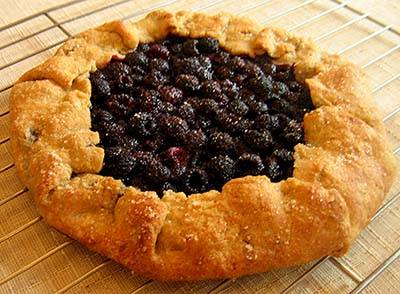 This year’s long, cool spring made for an explosion of strawberries, raspberries, blueberries, and cherries. As riders on Saturday’s Tour de Fruit learned: plums, apricots, pears, and apples won’t be far behind.
This year’s long, cool spring made for an explosion of strawberries, raspberries, blueberries, and cherries. As riders on Saturday’s Tour de Fruit learned: plums, apricots, pears, and apples won’t be far behind.
Galettes are a great way to showcase the local harvest. They can provide a sweet ending to a meal. Or, you can leave out the sugar and use them for a savory starter when the first of the field tomatoes arrive.
Adapted from a Julia Child recipe, this dough uses cornmeal for texture and to keep the dough from tearing when rolled. You don’t need special tools to make a galette, your hands and an ordinary baking sheet will suffice. Though you will need parchment paper which is now available at most grocery stores.
If you’ve never made pie crust or tart dough from scratch, galettes are a great way to start. Their free-form is more forgiving. So, if you accidentally stretch the dough, there won’t be signs of sagging or shrinking to give you away as with regular pie crust or the denser pate sucree used for fruit tarts. If you substitute all-purpose flour for the whole wheat, increase the water to 5 T.
Whole Grain Sweet or Savory Galette
3 T yogurt
4 ½ T ice water
1 c stone ground, whole white wheat all-purpose flour
¼ stone ground yellow cornmeal
1 t sugar
½ t salt
7 T cold, unsalted butter
Combine yogurt and water in a measuring cup and set aside. Stir dry ingredients in bowl. Cut butter into six to eight pieces. Drop the butter into the flour and use your hands to coat it. Work in the butter with a pastry cutter, or if you don’t have one, you can use your hands. Pick up handfuls of the mixture and gently rub them into flour/meal-covered butter flakes by taking your thumbs over your finger tips. When the mixture resembles coarse meal with a few pea-sized pieces, add the yogurt-water mixture 1 T at a time, sprinkling it over the top of the dough. The dough should stick together when pressed. If the dough is still dry, add plain cold water 1 t at a time, gathering it together in a cohesive ball.
Divide the dough in half and pat each into a disk. Wrap each with plastic and refrigerate for two hours or up to two days. If you wrap it air-tight, you can freeze it for up to a month, thawing it in the refrigerator.
When dough is chilled or thawed, preheat oven to 400 degrees F and line a baking sheet with a piece of parchment paper. Place the dough on a lightly floured surface. Roll into an 11-inch circle about 1/8-inch thick. Lift the dough occasionally, placing more flour under it as you are rolling it out to keep it from sticking. Roll it onto the rolling pin and transfer to the baking sheet.
For a fruit galette, spread 1 ½ c of berries or sliced stone fruits or apples on the dough, leaving a 2- to 3-inch border. Sprinkle with 1 T of sugar and drizzle with 1 T of honey or diluted jam or syrup. Cut 1 T of butter into small pieces and toss it over the top of the berries. Begin folding the dough up over the berries, allowing it to pleat as you go around the tart, so it maintains its circular form. If desired, brush the crust lightly with water and sprinkle with 1 t of sugar. Bake for 35 to 40 minutes or until golden and crisp. Cool on baking sheet on a rack for 10 minutes. Then, slide the galette loose with a spatula and cool directly on the rack. Cut with a pizza wheel or sharp knife.
If you want to make a savory one, omit the sugar in the final decoration with water and sugar. Fill with 4 oz of grated soft cheese layered with 2 to 3 tomatoes sliced ¼-inch thick and arranged concentrically. Bake for 35 to 40 minutes and cool as above. Garnish with 2 to 4 T of thinly sliced basil. Serve warm or at room temperature. Alternatively, you can fill the tart with roasted summer vegetables. In the spring, you can use a combination of mushrooms, ramps, asparagus, and/or goat cheese, and in fall, sliced poached potatoes, carmelized onions, and cheese.
Regardless of the filling, galettes are best eaten the same day they are made.








